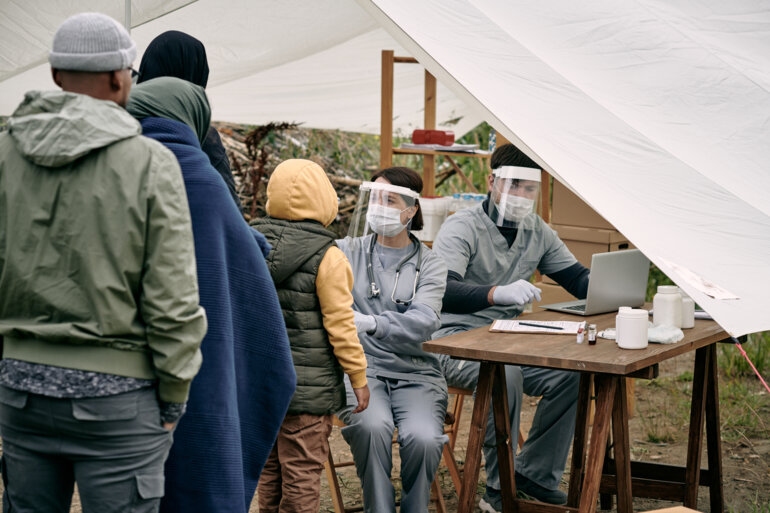Available data now allows evidence-based treatment of cancer diagnosed during pregnancy and new therapies are improving many young patients’ survival prospects, but couples’ preferences and values must continue to guide medical teams even when hope is scarce
To most people, the harrowing experience of receiving a cancer diagnosis is worlds apart from the joy of bringing a child into the world. Occurring concomitantly in about one in 1,000 pregnancies, the diagnosis of cancer during pregnancy is rare but expected to become more common due to factors including a general trend towards delayed childbearing (Cancers 2020;12(12):3616), and often leaves families overwhelmed and unsure how to move forward. For some couples facing cancer, desire for parenthood is nurtured by the hope of being cured by new therapies or of beating the prognostic odds, however it has to be counterbalanced by the most realistic perspective of seeing a child grow up years after a parent’s diagnosis.
Counselling patients who are seeking pregnancy despite advanced cancer and a grim prognosis is challenging for medical oncologists. The well-known story of neurosurgeon Paul Kalanithi described in his memoir, When Breath Becomes Air, has a lot to teach on the psychological state in which a patient’s wish for parenthood may arise offering a better understanding of aspects which must be carefully taken into account in the doctor-patient discussion. Diagnosed in 2013 with stage IV lung cancer at the age of 36, Kalanithi decided with his wife, Lucy, to start a family knowing with near certainty to leave his child half-orphan in a short time. Their daughter was born in 2014, days after Kalanithi came home from a long hospital stay following a disease relapse, considerably weakened.
Some argue that no personal preference should be considered off limits in these complex situations, calling on oncologists to help patients make well-informed choices and provide them with unconditional support. This difficult task also includes carefully assessing risks associated with therapy or its interruption, finding a balance between nurturing a patient's hope to get better without facilitating a false hope and considering responsibilities towards the unborn child (ESMO Open. 2020 Nov;5(6):e000956).
Accumulating evidence warrants an attitude shift
Common malignancies among young adults between the ages of 20 and 39 are cervical cancers, thyroid cancers, leukaemia, colorectal cancers and female breast cancers (Lancet Oncol. 2017 December 1;18(12):1579-1589), about 6% of which are diagnosed in women under the age of 40 (J Thorac Dis. 2013;5(S1):S68-S80). Improved survival outcomes have been accompanied by an increased focus on offering timely reproductive health counselling and fertility preservation measures to allow those patients who wish it to have children after anticancer treatments (Ann Oncol. 2020 December 1;31(12):1664-1678), as some of them cause infertility and early menopause. The possibility of having a baby during active treatment for cancer, meanwhile, remains largely unaddressed as a family issue and mainly limited to women with cancer being advised to remain on contraception during this phase of their disease journey.
Pregnant women with cancer can be offered the same standard of care as non-pregnant patients and do not have to choose between preserving their baby’s health or their own.
Also, to date, the critical issue of bringing a child into a family’s battle with cancer has been mostly investigated in breast cancer. Prof. Matteo Lambertini, IRCCS Ospedale Policlinico San Martino – University of Genova, Italy, specialises in fertility and pregnancy-related issues that young women with this tumour type can face: “The first important message to give to pregnant women who receive a diagnosis of cancer is that in most cases of early-stage disease, they can be offered the same standard of care as non-pregnant patients and do not have to choose between preserving their baby’s health or their own,” he says. While cautioning that treatments such as radiotherapy and endocrine therapy should be postponed until after the delivery due to their potential to affect foetal development, Lambertini points to a growing body of evidence showing that surgery to remove the tumour can be performed without additional risk to the mother or the unborn child and that various types of chemotherapy can be safely administered during the second and third trimesters of pregnancy without causing foetal malformations or other pregnancy-related complications (Cancers 2021 June 18;13(12):3048).
“The idea of receiving chemotherapy often makes patients and also their oncologists uncomfortable, because it is considered a demanding treatment even under normal circumstances and may seem it could harm the pregnancy as it crosses the placental barrier. We are now confident that this is not the case for most of the chemotherapy agents after the first trimester, but convincing women that they can be treated without endangering the foetus remains a significant challenge,” Lambertini reports.
Recognising that the decision to continue a pregnancy alongside cancer treatment or not belongs to the patient, he emphasises that the goal for physicians should be to clearly inform women about all the available evidence—and the areas where it is lacking, such as the ethical question about long-term health outcomes of children exposed to chemotherapy in utero (Cancers 2020 December 3;12(12):3623)—to help them make a choice in their unique situation. Even in the early disease setting, such conversations should also cover the relevant statistics about a patient’s prognosis according to her tumour type, which may lead the family to consider the possibility of premature death and leaving a future child alone with the surviving parent.
The first case of alectinib being given during pregnancy
The management of a pregnancy in cancers other than breast cancer has been poorly investigated so far, and lack of information on the teratogenicity of some new anticancer agents often leads oncologists to discuss abortion as an option to allow for optimal treatment. This is precisely what Dr. Martina Imbimbo, medical oncologist at the National Cancer Institute in Milan at the time, did when Anna, a 31-year-old patient with a diagnosis of metastatic ALK-rearranged non-small cell lung cancer (NSCLC), came to her with the news that she had become pregnant three months after starting treatment with the targeted drug alectinib (J Thorac Oncol. 2021 May 1;16(5):873-877). “It is typical for this medicine to start working quickly, sometimes within two weeks, and indeed Anna had an initial PET scan showing an almost complete response, including the disappearance of her brain metastases,” Imbimbo reports, recalling that although she had a strong desire for motherhood, the patient also knew the treatment was keeping her alive and immediately ruled out the possibility of discontinuing it.
The patient had to think about the possibility of having a sick child and the implications for her family of having a shortened life expectancy.
After she rejected the medical advice to terminate the pregnancy due to a suspected risk of pregnancy-related maternal complications and potential treatment-induced foetal malformations documented in rats, a multidisciplinary team allowed Anna to continue with intense psychological counselling and close monitoring by an obstetrics unit experienced in caring for cancer patients. Imbimbo says she felt like an adversary rather than an ally at the time: “I had to make clear to her that this would be the first case of alectinib being given during pregnancy in humans and that in addition to the possibility of having a sick child, she also had to think about the implications for her family of having a significantly shortened life expectancy.” In the end, it was the patient and her husband’s willingness to engage in these discussions openly and their acceptance of the possible negative outcomes that convinced Imbimbo they had made their choice consciously: “They were very brave in betting on things to go well, but we also reassured them that we would support them all the way and that they could still take action later if serious problems were detected during the prenatal monitoring,” says Imbimbo.
The patient received full-dose treatment throughout her pregnancy and continued to respond without any severe side-effects, while monitoring of the foetus revealed no congenital or growth abnormalities. A healthy baby girl was born by elective caesarean section one month before term. Evaluation of blood from the umbilical cord, amniotic fluid and placental tissue revealed that the placental barrier had reduced the baby’s exposure to alectinib by 14 times compared to her mother. Three years later, Anna is still in partial remission and able to take care of her daughter, who is developing normally.
Imbimbo insists this story cannot be interpreted as evidence that pregnancy is possible during treatment with tyrosine kinase inhibitors (TKIs) like alectinib. “We published the case report so that doctors who are confronted with a similar situation in the future have more information than we did initially: we would also have reported it if the outcomes had been different, which we know could easily have been the case,” she says, emphasising that Anna’s small stature likely contributed to her continued response to treatment despite being underdosed as a result of pregnancy-related physiological changes affecting the distribution of the medicine. Previous reports on lung cancer diagnosed in pregnant women (Lung Cancer 2013 October 2;82(3):499-505) have in fact highlighted dismal maternal outcomes with most patients passing away within weeks or months of delivery, consistent with the poor prognosis of a malignancy usually discovered in the advanced stages.
Fertility in the era of precision medicine
Research into the safety of novel anticancer agents in pregnancy is unlikely to move forward due to ethical issues related to the potential risk of foetal harm—but as young women with cancer see their survival chances and quality of life improve thanks to innovative therapeutic approaches, Lambertini expects that questions about fertility and pregnancy will need to be addressed more systematically in the future. “I recently had a patient with metastatic breast cancer who, after five years of targeted therapy and an ongoing complete response, came to me asking if she could stop the treatment and try to have a baby,” he notes, explaining that individual factors like the woman’s age, expectations and treatment duration would condition his response to such requests and that doctors should always make clear the potential prognostic implications of interrupting a chronic therapy.
In parallel, more in-depth considerations into the desire of parenthood of cancer patients must be addressed especially in light of the very long-term responses seen for instance with immune checkpoint inhibitors in melanoma. Lambertini agrees that a change in physicians’ mindset may be needed to help the youngest patients achieve the best possible outcomes for life and their desire for family after treatment. “The role of medical oncologists in 2021 is no longer limited to just treating cancer. It should also take into account families’ hopes and expectations for the future and support these in any way possible,” says Lambertini. “This also means that patients need to feel comfortable talking about their sexual health, fertility and desire for parenthood with their oncologists.”
Choosing life despite cancer is Paul Kalanithi’s legacy which materialised into his daughter Cady. Shortly before his death in the spring of 2015, he wrote about how he hoped she would think of him in later life: “Do not, I pray, discount that you filled a dying man’s days with a sated joy, a joy unknown to me in all my prior years, a joy that does not hunger for more and more, but rests, satisfied. In this time, right now, that is an enormous thing.”







